Battle of Narva 19 (30) November 1700 of the year
Karl XII sent additional forces to Estonia and Ingeria (about 10 thousand soldiers), who landed in Revel and Pernov. The Swedish king himself also arrived in Pernov along with his troops 5 (16) in October. He gave his forces quite a long rest. 12 (23) October Karl arrived in Revel and gave the order to Otto Welling with the main forces of his corps to move north to Wesenberg. October 25 (November 5) Karl XII arrived in Revel, where he met with the local population, he promised people additional privileges as part of the Swedish Empire.
Clash at Purc (Purtz)
Peter I, having received news of the landing of Swedish troops in Pernov, on September 26 (October 7) sent Boris Sheremetyev’s 5-thousandth cavalry unit along the Revel road. The distance from Narva to Revel was about 200 versts, the road went through marshland along the coast of the Gulf of Finland, and on the way were the village of Pyuhaiogi, the forts of Purts and Wesenberg. The small formations of the Swedes retreated to Revel. Sheremetyev's squad, meeting no resistance, passed 3 versts to 14 (100) in October, and took Wesenberg positions.
On October 25 (November 5), a squad of General Welling approached Wesenberg from the south. Upon learning of the approach of the Swedish troops, Sheremetyev decided to move to the 36 verst back to the Purc fortification and dispersed his squad into several settlements in the marshland east of Purc in order to block all roads leading to Narva. And the count himself with the main forces stopped in the village of Povanda.
The Swedes, taking advantage of the carelessness of the Russian soldiers who did not set up security, October 25 (November 5) recaptured Purtz, and October October (November November) the village Variel. Sheremetyev, having learned about it, sent a large detachment, the Swedes in Variiel were surrounded, but with a battle broke free and retreated. The captured Swedes reported false information about the approach of a large Swedish army (26-6 thousand people).
Count Boris Petrovich Sheremetev will be one of the best commanders of the Northern War, but one of his features was great caution. He decides not to hold the Purc line and move back another 33 versts to the village of Pühahoi. Sheremetev reasonably believed that his cavalry would find it difficult to hold back the onslaught of the Swedish forces in the marshy and wooded area.
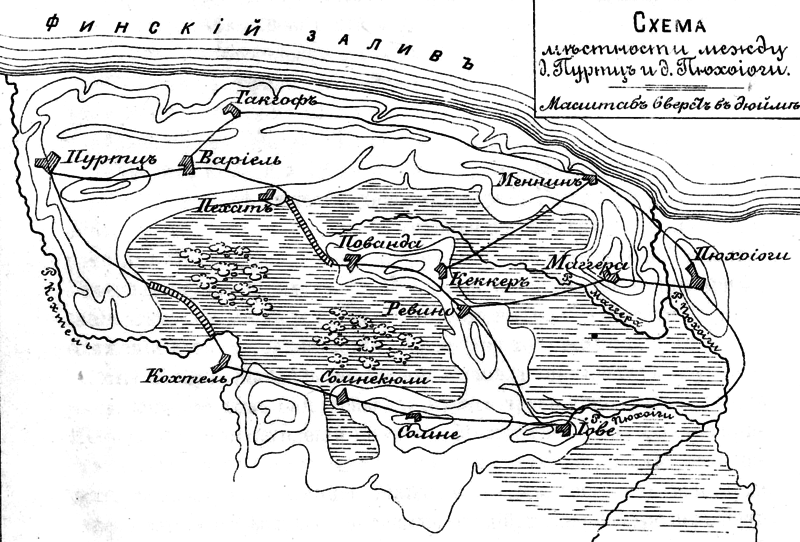
Neighborhood of Wesenberg and the path of retreat of Boris Sheremetev.
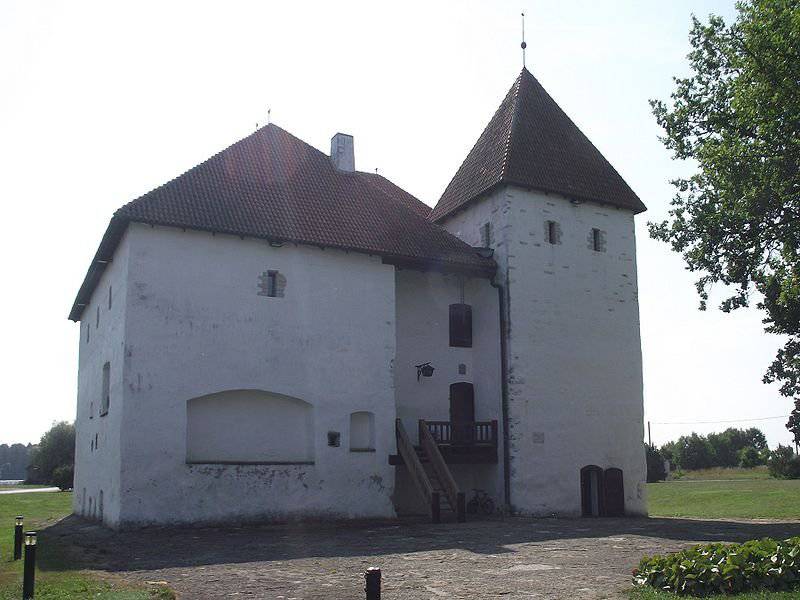
Strengthening Purtts.
Further actions of the parties
Initially, Karl did not concentrate all his forces on the battle with the Russian army near Narva, because he saw danger in the south of Estonia. In Novgorod land was a division under the command of Anikita Repnin and a detachment of Cossacks Ivan Obidovsky. In addition, the likelihood of new actions by the Saxon Elector Augustus II, who, although he had lifted the siege from Riga, was still able to join the Russian forces at Pskov and strike in the direction of Dorpat, remained. Karl XII left several thousand regular soldiers and militiamen for the defense of Revel, and for the actions in the southern direction he allocated a thousandth regiment under the command of General Wolmar Anton von Schlippenbach. October 26 (November 6) Schlieppenbach Reiters defeated the 1,5 ths. Pskov militia unit near Lake Ilmenskoye. In this fight, more than eight hundred Russian militias were killed, and Schlippenbach soldiers also captured a dozen Russian ships and the banner of the Pskov province.
Karl, having learned about the results of the collision with Purc, decides to move with a relatively small detachment in 4-5 thousand soldiers to Wesenberg. There his detachment joined the forces of General Welling. 12 (24) November the Swedish king, contrary to the advice of some of his generals, decided to march towards Narva.
Sheremetyev did not take into account his previous mistakes - intelligence was poorly organized and the approach of the Swedish forces was actually missed. In addition, most of his forces were busy searching for food and forage. At the key point of his defense, there were only 600 people. Karl did not neglect intelligence and knew about the position of the Russian forces. The Swedish army marched along two parallel roads, forcing down, by surprise and organization, small Russian cavalry detachments. As a result of November 16 (27), Sheremetyev was unable to organize resistance at the turn of the village of Pühajogi and retreated, causing Peter's ire.
Peter's departure, plans of the Russian and Swedish command
Peter, having assessed the situation, left for Novgorod on November 18 (29), leaving the command to Field Marshal de Croix (although he refused such an honor). After their victory in the battle of Narva, the Swedes spread the version that the Russian Tsar fled due to cowardice. In Sweden, they even issued a medal depicting Peter crying, fleeing from the fortress, the inscription on it was a quote from the Bible: "Exited, crying bitterly." The same hypothesis was then repeated by some Russian historians. But, apparently, this is an erroneous opinion. More serious historical research does not support him. Peter's biography speaks of his personal courage, this man was not afraid of difficulties, more than once found himself in the thick of battle, and put his life at stake. Apparently, one can talk about Peter underestimating Karl’s decisiveness and the capabilities of the Swedish army. The tsar, having received information about the small size of the Swedish army, did not assume that Karl would decide to attack the Russian fortified camp, where the larger Russian army was located, before reinforcements arrived. Therefore, the tsar decided to use this time, accelerating the arrival of additional forces, the delivery of ammunition and food, for negotiations with the Polish king on the interaction of forces to strike the Swedish army.
The generals, having received a message from Sheremetyeva about the approach of the Swedish army, did not know what to decide. At the military council, Sheremetyev offered to leave the fortifications and attack the Swedes themselves, but most of the generals decided to adhere to defensive tactics, taking advantage of the presence of fortified positions.
The bold determination of the Swedish king overturned Peter’s calculations: “Do the Swedes fear the Moscow men?” Said Karl and on November 19 led the troops into the attack. The security service of the Russian camp was set so badly that the Swedes easily reconnoitred their positions. Karl chose the traditional tactics for the Swedish army: to strike the center of the Russian positions with the main forces, break through them, and then separately destroy both wings.
The implementation of the plan was facilitated by the fact that the Russian positions were poorly prepared for defense. The Russian troops were very poorly located, it was difficult to defend the fortifications, since there was no depth of construction (all forces were located in one line) and reserves that could be easily transferred to the threatened sector. It was not possible to maneuver their superior forces, to provide each other mutual support. In addition, an enemy fortress was located in the rear, and it was necessary to look after it. The connection with the other bank could be made only through one floating bridge on the right flank of the defense.
The left flank was defended by the Weide division and Sheremetyev's cavalry, in the center, occupying part of the height Germansberg, Prince Trubetskoy's formation, on the right flank the Golovin division, including Semenovsky, Preobrazhensky, and Lefortovo regiments. The headquarters of the Russian army was on the extreme right flank, on the island of Camperholm. The total number of Russian forces is estimated at 34-40 thousand people, including irregular troops. 22 guns and 17 mortars were set up along the ramparts, the rest of the artillery was located at Ivangorod.
The Swedish army numbered up to 12 thousands of bayonets and sabers (21 infantry battalion, 46 cavalry squadrons and 37 guns).
Battle
On the night of November 19 of 30 (1700), the Swedish army secretly approached the center of the Russian army's location by forest paths, and from where it was not expected. After the rest, around 13 hours of the day the Swedes went on the offensive. They attacked in two groups: the column of the Villing (11 battalions and 22 squadron) went to the right of the height Germansberg, the other, Renschild (10 battalions, 12 squadrons, 21 gun), to the left of this hill. In front of the columns were shock five hundred-member detachments of grenadiers with fascines (a bunch of twigs, a bundle of brushwood), in order to cast a ditch. On the crest of the height, a battery was installed under the command of Baron Sheblad of 16 guns, and she opened fire on the center of Russian positions. 12 squadrons remain in reserve.
The weather favored the Swedish king, a strong wind with thick snow hit the Russian soldiers in the eyes (visibility was no more than 20 meters). Russian units managed to become a gun, but the shafts were protected only by a rare chain of shooters who defended the front in the 6 version. The fight began at 2 hours. The Swedes were able to use the surprise factor, threw the ditch with fascines, climbed the shaft, and within half an hour the defense in the center was broken in two places. First, parts of Trubetskoy, and behind them the left flank of Weide and the right Golovin, retreated. The army was cut into two parts, the artillery was lost, one began to crowd to the south, the other to the north. The confusion began, many felt that the foreign officers had betrayed them, the soldiers shouting: “The Germans betrayed us!”, Tried to kill them. Foreign generals and officers, saving their lives, surrendered to the Swedes in full force. The local cavalry Sheremetyeva tried to ford back across the Narova River. Sheremetyev himself successfully moved to the other side, but about 1 thousand people sank in an icy river.
But the battle was not yet lost. The Swedish army captured Germansberg, the center and key of the Russian defense, and began to push both wings of the Russian army into the flanks. The Swedish command concentrated its main efforts against the “northern grouping” divided by the Russian army. Initially, the overturned forces of Trubetskoy and Golovin ran to the bridge in disarray, he could not stand the crush and collapsed. There was nowhere to retreat, the discomfited forces of Golovin began to line up with the Preobrazhensky, Lefortovo and Semenov regiments, which did not succumb to general panic and occupied bridgehead reinforcement - “wagenburg” (or walking-city, mobile field reinforcement in the XV-XVIII centuries). Guardsmen Peter and Golovin units repulsed all the attacks of the Renschild forces. The Swedish king ordered Velling to single out several battalions in support of Renshild, and he himself advanced with selected troops for help. Karl personally led the Swedish troops on the attack, but the former "amusing" withstood the blow and did not give a single step to the Swedes. Karl said in admiration: "What are the men!" The Swedes suffered significant losses here.
The commander of the “southern grouping”, Veide, was able to assemble the units upset at the beginning of the battle, stopped the advance of the Welling column, and even pressed the Swedes. But as the local cavalry escaped and could not support his counterstrike, he could not do more. The night stopped the battle.
There was a stalemate. Karl cut the Russian army, defeated its center, the Russians lost their artillery, all foreign officers went over to the Swedes, the high command in the person of de Croix. But not a single Russian regiment folded weapons, each of the two Russian groups was equal in number to the Swedish army. The impossibility of retreat could have given the Russians a desperate determination to attack the enemy, and the simultaneous blow of the Russian forces from two sides could lead to the victory of the Russian army. A part of the Swedish infantrymen, having seized a wagon train in the Russian camp, looted it and got drunk. There was also a case of "friendly fire", characteristic of the Western armies - two Swedish battalions in the dark took each other for the Russians and began to fight each other.
The main problem of the Russian forces was the lack of intelligible command and communication among themselves. The remaining Russian commanders, having accurate information about the situation, could easily change the outcome of the battle in their favor.
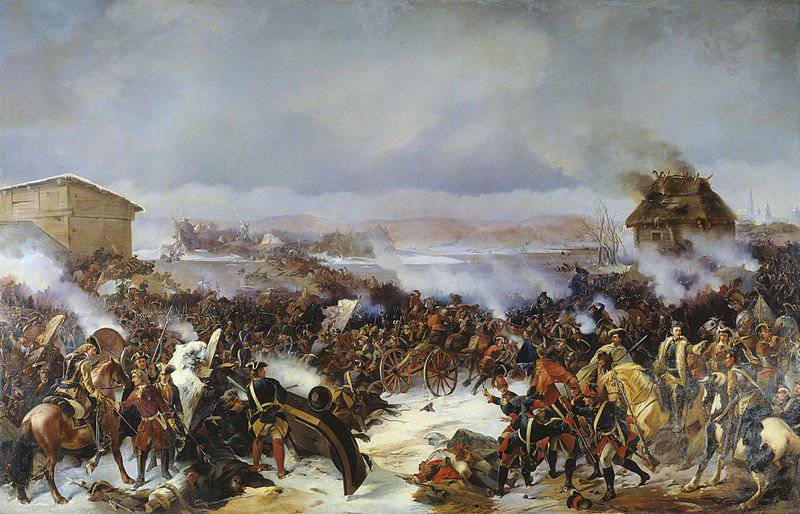
Painting A. E. Kotzebue "Battle of Narva".
Talks
Russian generals - Prince Yakov Dolgorukov, Avtomon Golovin, Ivan Buturlin, feldtseyhmeyster-general Tsarevich Alexander Imeretinsky, Adam Weide, having no precise information about the situation, decided to start negotiations. Carl, realizing the precariousness of his position, willingly went to meet their initiative.
In the course of the negotiations that began, an agreement was reached whereby Russian troops could honorfully retreat to the other side of the river, leaving themselves weapons and banners, the Swedes received artillery and a wagon train. Night from 19 to 20 in November (from 1 to 2 in December) 1700 of the Russian and Swedish sappers restored the crossing. On the morning of December 2, parts of the “northern grouping” began to be shipped to the other side. Part of the division Golovin with Preobrazhensky, Semenovsky, Lefortovo regiments freely crossed the river. But then Karl broke the agreement: the Swedes demanded that the units of the Weide division lay down their arms and flags, moreover, the Russian command and officers were taken prisoner. The soldiers of the Weide division were forced to give up their weapons and banners, and with “great abuse,” denouncing the Swedes and command, passed through the bridge.
Causes of defeat
- Poor organization of intelligence and local cavalry actions. More successful actions of Sheremetyev's cavalry against General Welling could delay the campaign of Charles until the spring-summer of 1701, a more convenient time for military operations.
“The pre-war reorganization of the Russian army temporarily weakened it, the new standards were not yet fixed, and the old mechanisms were broken. Ideally, Peter and his commanders needed several years of hostilities with a weak opponent in order to consolidate positive beginnings, discard erroneous ones. And the Russian army almost immediately collided with the first-class, "invincible" army of the Swedish Empire. The exam was very tough. It must be said, despite the general defeat, the Russian soldiers and part of the commanders showed themselves from the best side, having stood under the blows of the hardened soldiers of Karl.
- Some authors believe that the main cause of the defeat was the disorganization of command. The high command was passive, the use of foreign military experts was not justified.
- Bad defense organization. The place for the battle was extremely unsuccessful: the troops were clamped between the two shaft lines, could not maneuver, build a deeper defense, assist each other, transfer reserves, there was a strong enemy fortress in the rear.
- Skillful use by the Swedish command of the weak points of the Russian defense - the Swedes managed to hit the junction of the Russian divisions, to dismember the Russian army into two parts.
Results
- The Russian army lost 7 thousand killed, drowned, deserted. The Swedes, violating the agreement, captured 700 people, including 10 generals, 56 officers (including A. Weide, A. Imeretinsky, I. Buturlina, J. Dolgoruky - they were held captive until 1710, I. Trubtskoy, And Golovin - exchanged for Count Renshild only at the end of 1718 of the year, etc.). The Swedes seized 195 guns, 20 thousand muskets, 210 banners, the royal treasury in 32 thousand rubles.
- Swedish casualties made 2 thousand killed and wounded.
“It was a heavy defeat for the Russian army: heavy casualties were incurred, the army was actually beheaded by the surrender of foreign officers and the treacherous capture of the most talented Russian commanders, a significant amount of artillery was lost. In Western Europe, after the Battle of Narva, the Russian army was no longer perceived as a serious force for several years. The European press warmly supported this idea, foreign diplomats laughed at the Russian envoys. There were even rumors of new hard defeats for Russia and the seizure of power by Princess Sophia. Narva defeat was considered in Europe as an irreparable catastrophe.
The Swedish king received the glory of a great commander. But, on the other hand, this victory sowed the seeds of the future defeat of the Swedish empire - Karl believed that he had defeated the Russian armed forces for a long time and did not develop his success, having decided to focus on the Saxons. Such a factor as Carl’s hatred for the Saxon ruler played his role, the Swedish king considered him to be the initiator of the anti-Swedish alliance, the main conspirator who must be severely punished. "His behavior is so disgraceful and disgusting," Karl responded about Augustus, "that he deserves revenge from God and the contempt of all good-minded people." He greatly underestimated the Russian army until the Battle of Poltava. Karl did not go to the world, although Peter, with the mediation of Austrian and French diplomats, was ready for negotiations. The Russian tsar, on the contrary, after a crushing defeat, developed vigorous activity, carried out work on mistakes, and emphasized on the training of Russian officers.
- There was a serious danger of the invasion of the Swedish army in the inner regions of Russia in 1701 year. The Russian tsar had to hastily strengthen the north-western frontiers of the state, the troops remaining at his disposal, on pain of death, were forbidden to retreat from the line of defense Pskov-Novgorod-Arkhangelsk. The construction of new fortifications and the repair of old ones, mobilization for the work of the population begins.
- The battle of Narva ended the 1700 campaign of the year. She was unsuccessful for the Allies. Swedish troops achieved major strategic successes: Denmark was withdrawn from the war, the Saxons lifted the siege from Riga and retreated, the Russian army was defeated near Narva.
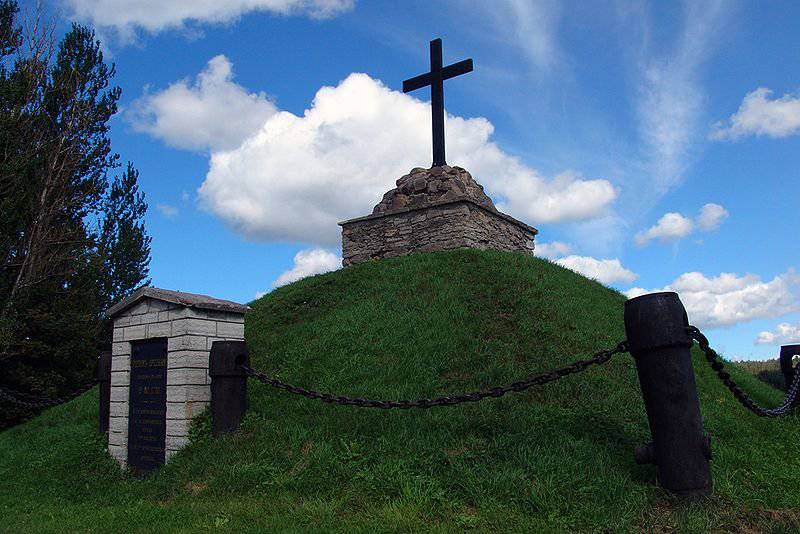
Monument to Russian soldiers. In 1900, the 200 anniversary of the first battle of Narva, initiated by the Preobrazhensky, Semenov regiments and the 1 battery of the Life Guards 1 artillery brigade, near the village of Vepskyl, built a monument to the fallen Russian soldiers.
Application. Battle score by Peter.
“The Swedes under Narvo over our army, Victoria (victory) got what is indisputable; but it should be understood what army they were given: only one old Lefortov regiment was, and two guards regiments (Preobrazhensky and Semenovsky) were only in two attacks from Azov, and those field battles, never seen before, with regular troops. The rest of the regiments, both officers and privates, were the most recruits; and, moreover, in the late period of time, there was a great famine, it was impossible to bring provisions after the great mud. In a single word, you can say: the whole thing was like a child's play, and art was below the form. What is the surprise of the old, trained, practiced army over such ungraceful to find Victoria? True, this victory at that time was very sad and sensitive, supposedly desperate for all sorts of hope in the future. But when to think about that, then ... if we would get Victoria over the Swedes, who were so blundering in all matters, both military and political, then what trouble could they have been later than the Swedes long ago, in all things trained and glorious in Europe (which the French called the German scourge), under Poltava so cruelly cast down that all their maxim (majesty) turned upside down. But when we got this misfortune (or, better to say, great happiness) under Narva, we were driven away by bondage and diligence to art and day and night, and forced the war to wage war with fear and art. ”
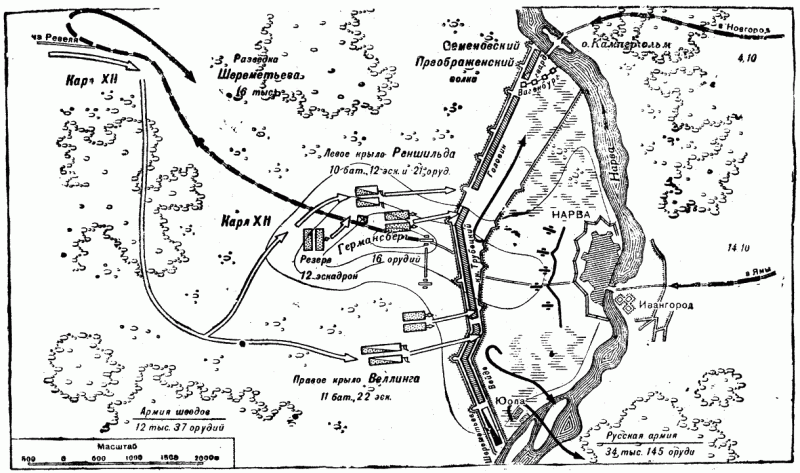
Information